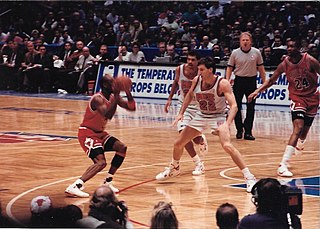
Basketball is a team sport in which two teams, most commonly of five players each, opposing one another on a rectangular court, compete with the primary objective of shooting a basketball through the defender's hoop, while preventing the opposing team from shooting through their own hoop. A field goal is worth two points, unless made from behind the three-point line, when it is worth three. After a foul, timed play stops and the player fouled or designated to shoot a technical foul is given one, two or three one-point free throws. The team with the most points at the end of the game wins, but if regulation play expires with the score tied, an additional period of play (overtime) is mandated.

A shot clock is a countdown timer used in a variety of games and sports, indicating a set amount of time that a team may possess the object of play before attempting to score a goal. Shot clocks are used in several sports including basketball, water polo, canoe polo, lacrosse, poker, ringette, korfball, tennis, ten-pin bowling, and various cue sports. It is analogous with the play clock used in American and Canadian football, and the pitch clock used in baseball. This article deals chiefly with the shot clock used in basketball.
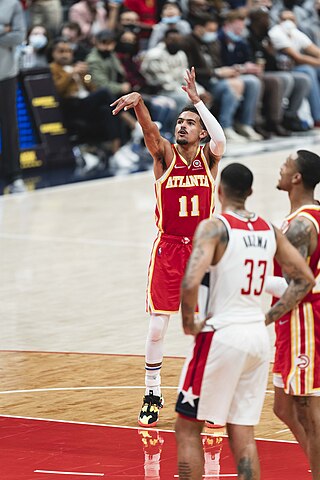
In basketball, free throws or foul shots are unopposed attempts to score points by shooting from behind the free-throw line, a line situated at the end of the restricted area. Free throws are generally awarded after a foul on the shooter by the opposing team, analogous to penalty shots in other team sports. Free throws are also awarded in other situations, including technical fouls, and when the fouling team has entered the bonus/penalty situation. Also, depending on the situation, a player may be awarded between one and three free throws. Each successful free throw is worth one point.
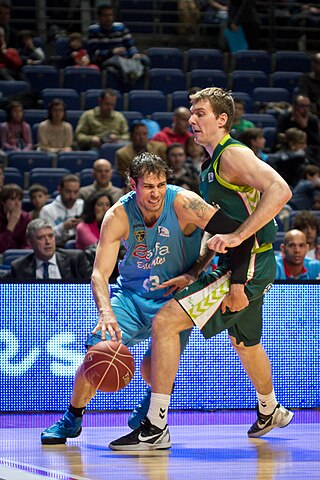
In basketball, a personal foul is a breach of the rules that concerns illegal personal contact with an opponent. It is the most common type of foul in basketball. A player fouls out on reaching a limit on personal fouls for the game and is disqualified from participation in the remainder of the game.

Streetball is a variation of basketball, typically played on outdoor courts and featuring significantly less formal structure and enforcement of the game's rules. As such, its format is more conducive to allowing players to publicly showcase their own individual skills. Streetball may also refer to other urban sports played on asphalt. It is particularly popular and important in New York City and Los Angeles, though its popularity has spread across the United States due to the game's adaptability.

The rules of basketball are the rules and regulations that govern the play, officiating, equipment and procedures of basketball. While many of the basic rules are uniform throughout the world, variations do exist. Most leagues or governing bodies in North America, the most important of which are the National Basketball Association and NCAA, formulate their own rules. In addition, the Technical Commission of the International Basketball Federation (FIBA) determines rules for international play; most leagues outside North America use the complete FIBA ruleset.

Double Dribble is an arcade basketball video game developed and released by Konami in 1986. It was the second basketball arcade video game by Konami, following Super Basketball. It was considered the most realistic basketball sports video game upon release, with fast-paced action, detailed players, a large side-scrolling court, innovative cinematic slam dunks, and detailed sound effects, beginning a trend where presentation would play an increasingly important role in sports games.

In timed sports, a buzzer beater is a shot that is taken just before the game clock of a quarter, a half, or an overtime period expires, but does not go in the basket until after the clock expires and the buzzer sounds, hence the name "buzzer beater". In basketball, the concept normally applies to baskets that beat an end-of-quarter/2nd-half/overtime buzzer but is sometimes applied to shots that beat the shot clock buzzer.

The 1990 NBA Finals was the championship round of the 1989–90 National Basketball Association (NBA) season, and the conclusion of the season's playoffs. The series pitted the defending NBA and Eastern Conference champion Detroit Pistons against the Western Conference champion Portland Trail Blazers.
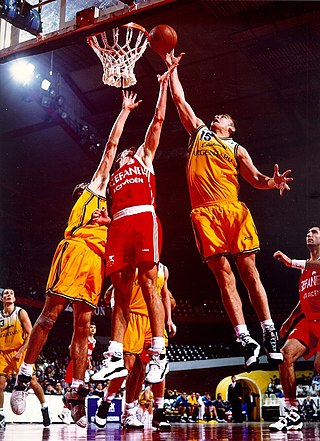
In basketball, a rebound, sometimes colloquially referred to as a board, is a statistic awarded to a player who retrieves the ball after a missed field goal or free throw.

This glossary of basketball terms is a list of definitions of terms used in the game of basketball. Like any other major sport, basketball features its own extensive vocabulary of unique words and phrases used by players, coaches, sports journalists, commentators, and fans.
Variations of basketball are games or activities based on, or similar in origin to, the game of basketball, in which the player utilizes common basketball skills. Some are essentially identical to basketball, with only minor rules changes, while others are more distant and arguably not simple variations but distinct games. Other variations include children's games, contests or activities intended to help the player practice or reinforce skills, which may or may not have a competitive aspect. Most of the variations are played in informal settings, without the presence of referees or other officials and sometimes without strict adherence to official game rules.

The key, officially referred to as the free throw lane by the National Basketball Association (NBA), the National Collegiate Athletic Association (NCAA), the National Association of Intercollegiate Athletics (NAIA), and the National Federation of State High School Associations (NFHS), and the restricted area by the International Basketball Federation (FIBA), is a marked area on a basketball court surrounding the basket, where much of the game's action takes place.

The 2009 WNBA Finals was the championship series of the 2009 WNBA season, and the conclusion of the season's playoffs. The Indiana Fever, top-seeded champions of the Eastern Conference, faced the Phoenix Mercury, top-seeded champions of the Western Conference. The Phoenix Mercury defeated the Indiana Fever 3 games to 2 to win their second WNBA Finals title.
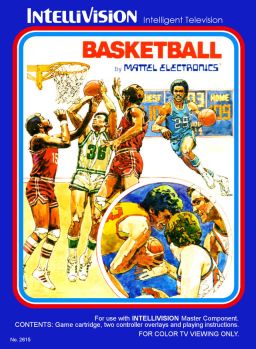
Basketball is a multiplayer sports video game produced by Mattel and released for its Intellivision video game system in 1980. The players each control a basketball team competing in four timed quarters of game play. Mattel obtained a license from National Basketball Association and used the NBA logo in its box art, making it first basketball video game to be licensed by the NBA. NBA Basketball does not use any official team or player names. It was sold by Sears for its private-label version of the Intellivision console, the "Super Video Arcade", without the NBA name or logo.
Basketball is a ball game and team sport in which two teams of five players try to score points by throwing or "shooting" a ball through the top of a basketball hoop while following a set of rules. Since being developed by James Naismith as a non-contact game that almost anyone can play, basketball has undergone many different rule variations, eventually evolving into the NBA-style game known today. Basketball is one of the most popular and widely viewed sports in the world.

The 2012 NBA Finals was the championship series of the National Basketball Association's (NBA) 2011–12 season, and the conclusion of the season's playoffs, contested between the Eastern Conference champion Miami Heat defeated the Western Conference champion Oklahoma City Thunder. It was played from June 12 to 21, 2012.

The 1999–2000 Georgetown Hoyas men's basketball team represented Georgetown University in the 1999–2000 NCAA Division I college basketball season. The Hoyas were coached by Craig Esherick in his first full season as head coach; he had replaced John Thompson in mid-season the previous year after Thompson's resignation. The Hoyas played most of their home games at the MCI Center in Washington, DC, although they played two home games at McDonough Gymnasium on the Georgetown campus. They were members of the Big East Conference and finished the season 19-15, 6-10 in Big East play. They advanced to the semifinals of the 2000 Big East men's basketball tournament before losing to Connecticut. Not invited to the NCAA tournament, they appeared in the 2000 National Invitation Tournament (NIT) – their third consecutive NIT appearance – and advanced to the second round before losing to California.

Big3 is a 3-on-3 basketball league founded by hip-hop musician and actor Ice Cube and entertainment executive Jeff Kwatinetz. The league consists of 12 teams whose rosters include both former NBA players and international players. The rules of Big3 games contain deviations from the official rules of 3-on-3 basketball as administered by FIBA. In January 2020, Big3 announced its rule set would be the core of a new basketball variant called "Fireball3".

The 2021–22 Michigan State Spartans men's basketball team represented Michigan State University in the 2021–22 NCAA Division I men's basketball season. The Spartans were led by 27th-year head coach Tom Izzo and played their home games at Breslin Center in East Lansing, Michigan as members of the Big Ten Conference. The Spartans finished the season 23–13, 11–9 in Big Ten play to finish in a tie for seventh place. As the No. 7 seed in the Big Ten tournament, they defeated Maryland and Wisconsin to advance to the semifinals where they lost to Purdue. They received an at-large bid to the NCAA tournament as the No. 7 seed in the West region, marking MSU's 24th straight trip to the NCAA tournament, the second longest active streak. They defeated Davidson in the first round before losing to Duke in the second round.
















